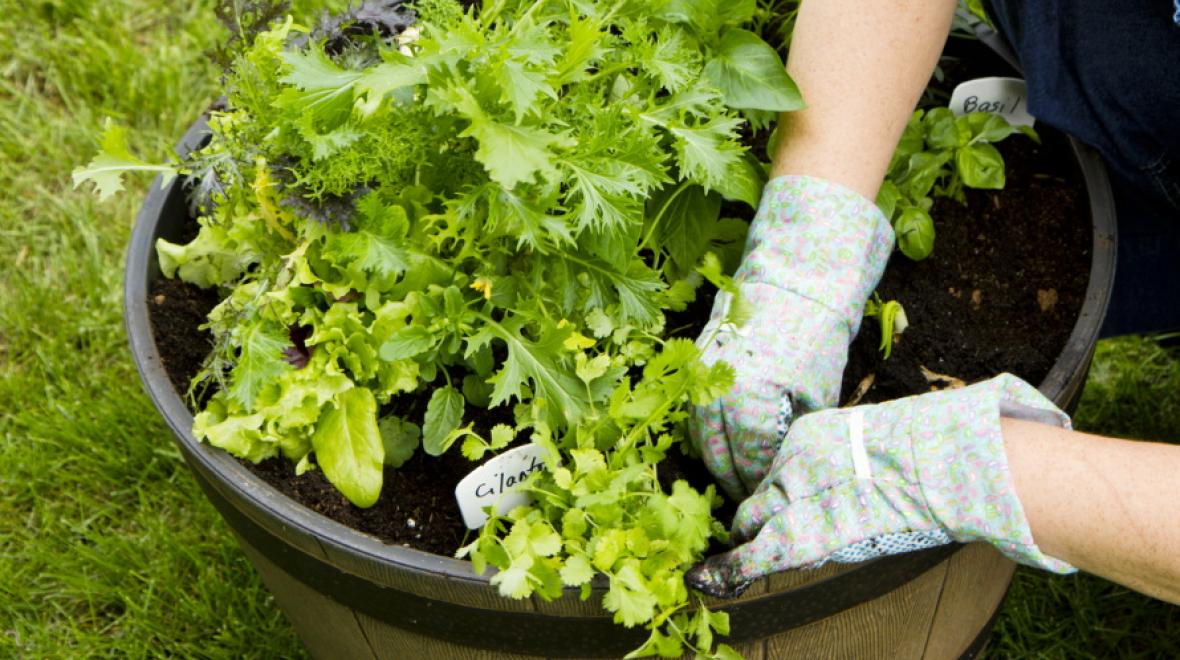
With more and more families growing their own food, you may be wishing that you had some land so that you could join the trend. But, believe it or not, even a city dweller can create a thriving edible garden for and with the family — regardless of limited space or patio size! Sure, a little creativity may be needed, but there are several techniques for maximizing your non-traditional garden space, with two of the most popular being container gardening and co-planting.
The lowdown on container gardening
Container gardens have been used to cultivate produce since the pharaohs ruled Egypt. The Egyptians began using containers to cultivate highly prized exotic plants from far-off lands. Today, you can use container gardening methods to maximize your small garden space, introduce your children to the wonders of gardening and teach them about the natural food cycle, or to just provide your family with a little food, freshness and fun.
Container gardening has many positives — and some people who do have the space to create a traditional garden even prefer to maintain a container garden. Containers can be arranged at a variety of heights to suit the needs of your family. Soil can be mixed to meet the specific needs of the plant you are growing. Some containers can be moved to maximize sun/shade and temperature fluctuations. Almost anything that holds soil (and to which you can add drainage holes) can be used for container gardening. Unconventional space-saving containers can also include the use of vertical gardens, hanging gardens and stepped plantings.
Maximizing your space
When selecting containers for your garden, you need to first think about your space and planting requirements. For example, your plants’ rooting needs will determine the depth of each plant’s container. If you are gardening on a balcony or a rooftop, weight may also be a consideration — fiber and plastic are significantly lighter than wood and clay pots. Aesthetics are another factor for reflection; while your tomatoes may not care that they are being grown in a bucket with a hole in it, you may decide that a more beautiful vessel will enhance your experience. Let your children decorate a few containers — this is a great opportunity for the kids to show off their artwork! Overall, be sure to reserve a container or two that are just for your kids.
Great edibles for container gardening
Greens and lettuces grow well in containers, and they’re a favorite among urban family gardeners. Chard and kale not only work well as interest plants, but they’re also great container veggies for the cooler winter season. Lettuces can be grown in a variety of situations and harvested by simply clipping the leaves off as you need them. Lettuce has even become popular as a filler veggie in flower baskets. So, if you want a good-looking basket that sits on your porch for the world to see, you should consider planting a flower basket with geraniums or impatiens for show, and a little lettuce for harvesting. Lettuces can also grow well in other unconventional containers, such as old wheelbarrows or even recycled rain gutters that are mounted on a wall or other vertical surface.
As for strawberries, they may as well be the poster plant for container gardening! You can use a traditional strawberry pot and get a decent harvest. Hanging baskets and tubes are also great options for offering up a deliciously sweet bounty. Overall, strawberries are an easy, low-maintenance edible that can grow well in any container.
Potatoes also work perfectly as great container edibles. It may even be beneficial to grow potatoes in a container rather than in the ground since you need to rotate potato crops yearly to reduce the chance of disease. You can even grow potatoes in a garbage can!
Tomatoes are another fun plantable that can be grown in a variety of unconventional ways. Straw bales (not exactly containers, but not traditional garden beds either!) make a great planting foundation for small tomatoes, herbs and many other vegetables. Place the bales on your balcony, porch or front path. But, be warned, once you start them, they can be too heavy to move, so pick a spot that will be good for all seasons. Smaller tomatoes grow best in Puget Sound since the summer growing season tends to be short. Tomatoes can also be grown upside down in hanging containers — another creative and fun way that works well in small spaces.
Fruit trees
You might be surprised to learn that with a little ingenuity, you can also have a container-ized fruit tree or two in your small garden — with espalier or flat trees being great small-space options. With three varieties of the same fruit grafted on to each tree, fruit trees are self-pollinating, meaning that you’ll only need to have one tree for an edible harvest. Espalier apple, pear or cherry trees can easily be grown in a large pot. Large nurseries such as Portland Avenue Nursery in Tacoma or Swansons Nursery in Seattle, carry a good selection each spring.
Columnar apple trees are another option: Their compact design keeps fruit and branches compact and close to the tree, allowing for an easy harvest for your little ones. These trees bear full-sized fruit, often during the first year after planting; and they’re less than two feet wide, making them a great pick for flanked entryway edibles. Keep in mind that if you decide that columnar trees are your style, you will need two for pollination.
Perennials such as rhubarb, chives, herbs (also annual), cabbage, peppers and eggplants are also excellent choices for container gardening. Speak to the folks at your local nursery for more suggestions on edibles that will grow well in your area.
Sharing space and co-planting
The term co-planting (or companion planting) refers to growing different plants together so as to encourage mutual benefits. Companion planting can create many pluses for your garden — including natural pest control, improved garden health and maximized garden space. For those without a lot of land to garden, space maximization may be the most important benefit! In her book “Carrots Love Tomatoes,” Louise Riotte explains that getting to know good and bad plant companions can double the bounty of your garden.
To incorporate co-planting into a small garden space, consider which starts can be planted together based on soil requirements, seasonal timing, root depth, lighting needs, watering needs, fertilizing needs and so on. For example, you might consider trellising sun-loving plants (such as squash) on a deck rail over shade-loving plants (such as lettuce). This will save valuable garden space and create an environment that works well for both plants. Additionally, co-planting can help to create a more child-friendly garden featuring a fun mix of plants in the same space. Exploring the idea of friends, companions and foes in the garden can also become a topic for discussion with your kids.
If you have a 10 x 10 patch of soil, try the Native American planting technique referred to as a “three sisters garden,” in which corn, beans and squash will work together to provide a healthy harvest. The “sisters” are planted in stages, allowing each some time to become established before the next is planted. Another easy way to save space is to intersperse flowers and herbs throughout your garden. Marigolds, mints and sweet basil work triple duty as interest plants, food and insect repellents when planted in your garden and/or on your patio. For an extended list of companion planting options, reference “The Encyclopedia of Organic Gardening.”
Harvesting your plants
Gardening, especially with children, is an ongoing learning experience. Take notes and don’t be afraid to make changes each year. No matter the size or shape of your garden space, a successful family edible garden can be best measured by the memories that you harvest. Have fun, experiment and let the kids do some of the work!
Anna Petersen is a freelance writer specializing in parenting, gardening, sustainability and community design.
Editor’s note: This article was originally published a few years ago and updated in March 2021.









